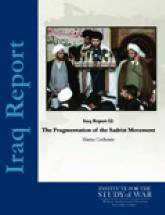 |
 |
The Fragmentation of the Sadrist Movement

Executive Summary
THE SADRIST MOVEMENT has steadily fragmented as a result of the Surge, competition among internal factions, and Prime Minister Maliki’s consolidation of power. Deliberate Coalition and Iraqi military operations, and Iraqi political maneuvers, have severed the political, military, and social strands of the Sadr Movement, which no longer co-exist in the same entity and likely will not recombine in 2009 While the political and military power of the movement has declined, its traditional constituency; the urban Shi’a poor and rural Shi’a tribes; remains a large and politically-valuable electorate.
Two main factions within the movement now compete for control of the traditional Sadr constituency; the clerics and politicians (including al-Sadr) who emphasize a return to social, religious and educational programs; and an armed movement, Asaib Ahl al-Haq, which seeks to continue resistance against Coalition Forces. Both groups seek to operate in the political process. Existing frictions between Muqtada al-Sadr and the leaders of the military wing make it unlikely that the groups will combine assets in the near future. In light of these ongoing tensions, rival political groups such as Prime Minister Maliki’s Dawa Party and the Islamic Supreme Council of Iraq, have sought to co-opt the Sadr Movement’s key constituency of urban Shi’a poor and rural Shi’a tribes.
If Maliki succeeds in building a Parliamentary coalition with leaders from either Sadrist faction, he will most likely cement his hold on power in the 2009 elections and dramatically reshape the political environment in Iraq.